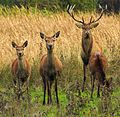Red deer
| Red deer Temporal range: EarlyMiddle Pleistoceneto Recent
| |
|---|---|
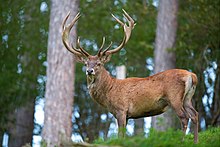
| |
| Male (stag) | |
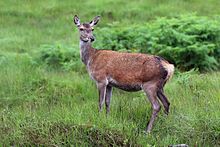
| |
| Female (hind) Glen Garry, Highland,Scotland | |
| Scientific classification | |
| Domain: | Eukaryota |
| Kingdom: | Animalia |
| Phylum: | Chordata |
| Class: | Mammalia |
| Order: | Artiodactyla |
| Family: | Cervidae |
| Subfamily: | Cervinae |
| Genus: | Cervus |
| Species: | C. elaphus
|
| Binomial name | |
| Cervus elaphus | |
| Subspecies | |
| |

| |
| Range of the red deer (Cervus elaphus), includes range ofCentral Asian red deer: reconstructed recent
| |
Thered deer(Cervus elaphus) is one of the largestdeerspecies. A male red deer is called astagorhart,and a female is called adoeorhind.The red deer inhabits most of Europe, theCaucasus Mountainsregion,Anatolia,Iran,and parts ofwestern Asia.It also inhabits theAtlas MountainsofNorthern Africa;being the only living species of deer to inhabit Africa. Red deer have been introduced to other areas, includingAustralia,New Zealand,theUnited States,Canada,Peru,Uruguay,ChileandArgentina.[2]In many parts of the world, the meat (venison) from red deer is used as a food source.
Red deer areruminants,characterized by a four-chambered stomach.Geneticevidence indicates that the red deer, as traditionally defined, is aspecies group,rather than a single species, though exactly how many species the group includes remains disputed.[3][4]The closely related and slightly largerAmerican elk,or wapiti, native to North America and northeastern Asia, had been regarded as a subspecies of red deer, but recently it has been established as a distinct species. The ancestor of all red deer (and wapiti) probably originated in central Asia and resembledsika deer.[5]
Although at one time red deer were rare in parts of Europe, they were never close to extinction. Reintroduction andconservationefforts, such as in the United Kingdom and Portugal,[6]have resulted in an increase of red deer populations, while other areas, such as North Africa, have continued to show a population decline.
Description
[edit]
The red deer is the fourth-largest extantdeerspecies, behind themoose,elk,andsambar deer.It is a ruminant, eating its food in two stages and having an even number of toes on each hoof, likecamels,goats,andcattle.European red deer have a relatively long tail compared with their Asian and North American relatives. Subtle differences in appearance are noted between the various subspecies of red deer, primarily in size and antlers, with the smallest being theCorsican red deerfound on the islands ofCorsicaandSardiniaand the largest being theCaspian red deer[7](or maral) of Asia Minor and the Caucasus Region to the west of theCaspian Sea.
The deer of central and western Europe vary greatly in size, with some of the largest deer found in theCarpathian Mountainsin Central Europe.[5]Western European red deer, historically, grew to large size given ample food supply (including people's crops), and descendants of introduced populations living inNew ZealandandArgentinahave grown quite large in both body and antler size. Large red deer stags, like the Caspian red deer or those of the Carpathian Mountains, may rival North American elk in size. Female red deer are much smaller than their male counterparts.

Size
[edit]The male (stag) red deer is typically 175 to 250 cm (69 to 98 in) long from the nose to the base of the tail and typically weighs 160 to 240 kg (350 to 530 lb); the female (hind) is 160 to 210 cm (63 to 83 in) long and often weighs 120 to 170 kg (260 to 370 lb).[8]The tail adds another12 to 19 cm (4+1⁄2to7+1⁄2in) and shoulder height is about 95 to 130 cm (37 to 51 in).[8]InScotland,stags average 201 cm (79 in) in head-and-body length and 122 cm (48 in) high at the shoulder and females average 180 cm (71 in) long and 114 cm (45 in) tall.[8]Based on body mass, they are likely the fourth largest extant deer species on average, behind themoose,theelkand thesambar deer.[9]
Size varies in different subspecies with the largest, the huge but small-antlered deer of the Carpathian Mountains (C. e. elaphus), weighing up to 500 kg (1,100 lb). At the other end of the scale, the Corsican red deer (C. e. corsicanus) weighs about 80 to 100 kg (180 to 220 lb), although red deer in poor habitats can weigh as little as 53 to 112 kg (120 to 250 lb).[10]
Neck mane
[edit]The males of many subspecies also grow a short neck mane during the autumn. The male deer of theBritish IslesandNorwaytend to have the thickest and most noticeable manes. Male Caspian red deer (C. e. maral) and Spanish red deer (C. e. hispanicus) do not carry neck manes. Male deer of all subspecies, however, tend to have stronger and thicker neck muscles than female deer, which may give them an appearance of having neck manes. Red deer hinds (females) do not have neck manes.
Antlers
[edit]Only the stags haveantlers,which start growing in the spring and are shed each year, usually at the end of winter. Antlers typically measure 71 cm (28 in) in total length and weigh 1 kg (2.2 lb), although large ones can grow to 115 cm (45 in) and weigh 5 kg (11 lb).[8]Antlers, which are made of bone, can grow at a rate of 2.5 cm (1 in) a day.[11]While an antler is growing, it is covered with highlyvascularskin calledvelvet,which supplies oxygen and nutrients to the growing bone.[12]
The antlers aretestosterone-driven and as the stag's testosterone levels drop in the autumn, the velvet is shed and the antlers stop growing.[11]With the approach of autumn, the antlers begin to calcify and the stags' testosterone production builds for the approaching rut (mating season).
European red deer antlers are distinctive in being rather straight andrugose,with the fourth and fifth tines forming a "crown" or "cup" in larger males. Any tines in excess of the fourth and fifth tines grow radially from the cup, which are generally absent in the antlers of smaller red deer, such as Corsican red deer. Western European red deer antlers feature "bez" (second) tines that are either absent or smaller than the brow tines. However, bez tines occur frequently in Norwegian red deer. Antlers of Caspian red deer carry large bez tines and form less-developed cups than western European red deer, their antlers are thus more like the "throw back" top tines of the North American elk (C. canadensis), known as maraloid characteristics. A stag can (exceptionally) have antlers with no tines, and is then known as a switch. Similarly, a stag that does not grow antlers is a hummel.
Coat
[edit]European red deer tend to be reddish-brown in their summer coats,[13]and some individuals may have a few spots on the backs of their summer coats.[5]During the autumn, all red deer subspecies grow thicker coats of hair, which helps to insulate them during the winter. Autumn is also when some of the stags grow their neck manes.[5]The autumn/winter coats of most subspecies are most distinct. The Caspian red deer's winter coat is greyer and has a larger and more distinguished light rump-patch (like wapiti and some central Asian red deer) compared with the Western European red deer, which has more of a greyish-brown coat with a darker yellowish rump patch in the winter.
By the time summer begins, the heavy winter coat has been shed; the animals are known to rub against trees and other objects to help remove hair from their bodies. Red deer have different colouration based on the seasons and types of habitats, with grey or lighter colouration prevalent in the winter and more reddish and darker coat colouration in the summer.[14]
Distribution
[edit]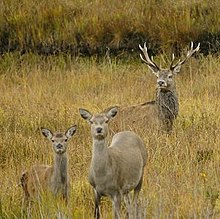
Europe and North Africa
[edit]The European red deer is found in southwestern Asia (Asia Minor and Caucasus regions), North Africa, and Europe. The red deer is the largest nondomesticated land mammal still existing inIreland.[15]TheBarbary stag(which resembles the western European red deer) is the only living member of the deer family native to Africa, with the population centred in the northwestern region of the continent in the Atlas Mountains.[16]As of the mid-1990s,Morocco,Tunisia,andAlgeriawere the only African countries known to have red deer.[1]
In the Netherlands, a large herd (about 3000 animals counted in late 2012) lives in theOostvaardersplassen,anature reserve.Ireland has its own unique subspecies. In France, the population is thriving, having multiplied five-fold in the last half-century, increasing from 30,000 in 1970 to around 160,000 in 2014. The deer has particularly expanded its footprint into forests at higher altitudes than before. In the UK, indigenous populations occur inScotland,theLake District,and thesouth west of England(principally onExmoor).[17]Not all of these are of entirely pure bloodlines, as some of these populations have been supplemented with deliberate releases of deer from parks, such asWarnhamorWoburn Abbey,in an attempt to increase antler sizes and body weights. TheUniversity of Edinburghfound that, in Scotland, extensive hybridisation with the closely related sika deer has occurred.[18]
Several other populations have originated either with "carted" deer kept forstag huntsbeing left out at the end of the hunt, escapes from deer farms, or deliberate releases. Carted deer were kept by stag hunts with no wild red deer in the locality and were normally recaptured after the hunt and used again; although the hunts are called "stag hunts", the Norwich Staghounds only hunted hinds (female red deer), and in 1950, at least eight hinds (some of which may have been pregnant) were known to be at large nearKimberleyandWest Harling;[19]they formed the basis of a new population based inThetford ForestinNorfolk.Further substantial red deer herds originated from escapes or deliberate releases in theNew Forest,thePeak District,Suffolk,Lancashire,Brecon Beacons,andNorth Yorkshire,as well as many other smaller populations scattered throughoutEnglandandWales,and they are all generally increasing in numbers and range. A census of deer populations in 2007 and again in 2011 coordinated by the British Deer Society records the red deer as having continued to expand their range in England and Wales since 2000,[20]with expansion most notable inthe MidlandsandEast Anglia.[21]
Iran
[edit]Caspian red deer are found in the Hyrcanian Forests.[22]
New Zealand
[edit]
InNew Zealand,red deer were introduced byacclimatisation societiesalong with other deer and game species. The first red deer to reach New Zealand were a pair sent byLord Petrein 1851 from his herd atThorndon Park,Essex, to the South Island, but the hind was shot before they had a chance to breed. Lord Petre sent another stag and two hinds in 1861, and these were liberated nearNelson,from where they quickly spread. The first deer to reach the North Island were a gift to SirFrederick WeldfromWindsor Great Parkand were released nearWellington;these were followed by further releases up to 1914.[23]Between 1851 and 1926, 220 separate liberations of red deer involved over 800 deer.[24]In 1927, theState Forest Serviceintroduced a bounty for red deer shot on their land, and in 1931, government control operations were commenced. Between 1931 and March 1975, 1,124,297 deer were killed on official operations.
The introduced red deer have adapted well and are widely hunted on both islands; many of the 220 introductions used deer originating from Scotland (Invermark) or one of the major deer parks in England, principally Warnham, Woburn Abbey or Windsor Great Park. Some hybridisation happened with the closely related American elk (Cervus canadensis nelsoni) introduced in Fiordland in 1921. Along with the other introduced deer species, they are, however, officially regarded as a noxious pest and are still heavily culled using professional hunters working with helicopters, or even poisoned.[citation needed]
Australia
[edit]The first red deer to reachAustraliawere probably the six thatPrince Albertsent in 1860 from Windsor Great Park to Thomas Chirnside, who was starting a herd atWerribee Park,south west of Melbourne in Victoria. Further introductions were made inNew South Wales,Queensland,South Australia,andWestern Australia.Today, red deer in Australia range from Queensland south through New South Wales into Victoria and across to South Australia, with the numbers increasing. The Queensland, Victorian and most New South Wales strains can still be traced to the early releases, but South Australia's population, along with all others, is now largely recent farm escapees. This is having adverse effects on the integrity of wild herds, as now more and larger herds are being grown due to the superior genetics that have been attained by selective breeding.
Wild red deer are a feral pest species in Australia, do considerable harm to the natural environment, and are a significant road traffic hazard.[25]
Argentina and Chile
[edit]In Argentina and Chile, the red deer has had a potentially adverse impact on native animal species, such as theSouth Andean deerorhuemul;the International Union for Conservation of Nature and Natural Resources has labelled the animal as one of the world's 100 worst invaders.[26]
Migration
[edit]Red deer in Europe generally spend their winters at lower altitudes in more wooded terrain. During the summer, they migrate to higher elevations where food supplies are greater and better for the calving season.
Taxonomy and evolution
[edit]Until recently, biologists considered the red deer and elk or wapiti (C. canadensis) the same species, forming a continuous distribution throughout temperate Eurasia and North America. This belief was based largely on the fully fertile hybrids that can be produced under captive conditions.[27][28][29]
Geneticevidence clearly shows the wapiti and red deer form two separate species.[30][31][32]
Another member of the red deer group which may represent a separate species isC. corsicanus.[33]If so,C. corsicanusincludes thesubspeciesC. e. barbarus(perhaps asynonymofC. e. corsicanus), and is restricted toMaghrebin North Africa,Corsica,andSardinia.[30][33]
A 2014mitochondrial DNAstudy showed the internal phylogeny ofCervusto be as follows:[34]
| Cervus |
| ||||||
|
Rusa(outgroup) | |||||||
Cervus elaphusappeared in Europe by the beginning of theMiddle Pleistocenearound 800,000 years ago. These earliest forms belonged to thepalaeosubspeciesCervus elaphus acoronatus.Other palaeosubspecies are known, including those belonging toC. elaphus rianensisfrom the Middle Pleistocene of Italy,C. elaphus siciliaefrom the late Middle and Late Pleistocene of Sicily.[35]
TheInternational Union for Conservation of Natureoriginally listed nine subspecies of red deer (Cervus elaphus): three asendangered,one asvulnerable,one asnear threatened,and four without enough data to give a category (Data Deficient). The species as a whole, however, is listed asleast concern.[1]However, this was based on the traditional classification of red deer as one species (Cervus elaphus), including the wapiti. The common red deer is also known as simply red deer.
Selected members of the red deerspecies groupare listed in the table below. Of the ones listed,C. e. hippelaphusandC. e. scoticusmay bejunior synonyms.[30]
| Name | Subspecies | Status | Historical range | Notes |
|---|---|---|---|---|
Central European or common red deer |
C. e. hippelaphus | Western and Central Europe, Balkans | Medium to large subspecies, with the largest deer found in theCarpathian Mountainsin Central Europe. It is light-coloured, with a light-coloured rump patch bordering with black. | |
Caspian red deerormaral |
C. e. maral | Asia Minor,Crimea,theCaucasusand northwesternIran | Large subspecies; its coat is dark grey, except in the summer, when it is a dark brown. | |
Norwegian red deer |
C. e. atlanticus | Norway | Small subspecies | |
Scottish red deer |
C. e. scoticus | England,ScotlandandIreland | This deer is slightly smaller than red deer in Western Europe and its coat is lighter in colour, with a distinct border to the lighter patch on the rump. | |
Spanish red deer |
C. e. hispanicus[36] | Iberian Peninsula | Smaller than the common red deer and more greyish in colour | |
Mesola red deer |
C. e. italicus | Once widespread across the Italian northeastern coast, but now restricted to Bosco della Mesola Nature Reserve | One of the smallest subspecies, similar to the Corsican and Atlas subspecies. | |
| Swedish red deer | C. e. elaphus | Critically Endangered | Sweden | |
Corsican red deer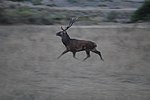 |
C. e. corsicanus | Near Threatened (NT)[37] | CorsicaandSardinia;[38]probably introduced there in historical times and identical with theBarbary stag[30] | One of the smallest subspecies |
Barbary stagorAtlas deer |
C. e. barbarus | Near Threatened | Morocco,AlgeriaandTunisia | One of the smallest subspecies |
Crimean red deer |
C. e. brauneri | Near Threatened | Crimea |
Behaviour
[edit]
Mature red deer (C. elaphus) usually stay in single-sex groups for most of the year. During the mating season, called therut,mature stags compete for the attentions of the hinds and will then try to defend the hinds they attract. Rival stags challenge opponents by belling and walking in parallel. This allows combatants to assess each other's antlers, body size and fighting prowess. If neither stag backs down, a clash of antlers can occur, and stags sometimes sustain serious injuries.[16]Red deer are among themammals exhibiting homosexual behavior.[39]
Dominant stags follow groups of hinds during the rut, from August into early winter. The stags may have as many as 20 hinds to keep from other, less attractive males.[40][citation needed]Only mature stags hold harems (groups of hinds), and breeding success peaks at about eight years of age. Stags two to four years old rarely hold harems and spend most of the rut on the periphery of larger harems, as do stags over 11 years old. Young and old stags that do acquire a harem hold it later in the breeding season than those stags in their prime. Harem-holding stags rarely feed and lose up to 20% of their body weight. Stags that enter the rut in poor condition are less likely to make it through to the peak conception period.[16]
Male European red deer have a distinctiveroarduring the rut, which is an adaptation to forested environments, in contrast to male American elk stags which "bugle" during the rut in adaptation to open environments. The male deer roars to keep his harem of females together. The females are initially attracted to those males that both roar most often and have the loudest roar call. Males also use the roar call when competing with other males for females during the rut, and along with other forms of posturing and antler fights, is a method used by the males to establish dominance.[13]Roaring is most common during the early dawn and late evening, which is also when thecrepusculardeer are most active in general.
Breeding, gestation and lifespan
[edit]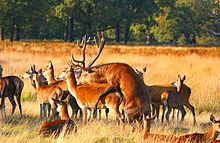

Female red deer reachsexual maturityat 2 years of age.[41]Red deer mating patterns usually involve a dozen or morematingattempts before the first successful one. There may be several more matings before the stag will seek out another mate in his harem. Females in their second autumn can produce one or very rarely two offspring per year. Thegestationperiod is 240 to 262 days, and the offspring weigh about 15 kg (35 lb). After two weeks, calves are able to join the herd and are fully weaned after two months.[42]The offspring will remain with their mothers for almost one full year, leaving around the time the next season's offspring are produced.[13]The gestation period is the same for all subspecies.[citation needed]
All red deer calves are born spotted, as is common with many deer species, and lose their spots by the end of summer. However, as in many species of Old World deer, some adults do retain a few spots on the backs of their summer coats.[5]
Red deer live over 20 years in captivity and in the wild they live 10 to 13 years, though some subspecies with less predation pressure average 15 years.[citation needed]
Protection from predators
[edit]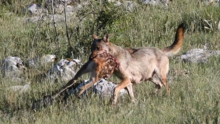
Male red deer retain their antlers for more than half the year, and are less gregarious and less likely to group with other males when they have antlers. The antlers provide self-defence, as does a strong front-leg kicking action performed by both sexes when attacked. Once the antlers are shed, stags tend to form bachelor groups which allow them to cooperatively work together. Herds tend to have one or more members watching for potential danger, while the remaining members eat and rest.[13]
After the rut, females form large herds of up to 50 individuals. The newborn calves are kept close to the hinds by a series of vocalizations between the two, and larger nurseries have an ongoing and constant chatter during the daytime hours. When approached by predators, the largest and most robust females may make a stand, using their front legs to kick at their attackers. Guttural grunts and posturing is used with all but the most determined of predators with great effectiveness. Aside from humans and domestic dogs, thegrey wolfis probably the most dangerous predator European red deer encounter. Occasionally, thebrown bearwill prey on European red deer.[13]
Red deer in folklore and art
[edit]
Red deer are widely depicted incave artfound throughout European caves, with some of the artwork dating from as early as 40,000 years ago, during theUpper Paleolithic.Siberiancave art from theNeolithicof 7,000 years ago has abundant depictions of red deer, including what can be described as spiritual artwork, indicating the importance of this mammal to the peoples of that region (Note: these animals were most likely wapiti (C. canadensis) in Siberia, not red deer).[43] Red deer are also often depicted onPictishstones (circa550–850 AD), from the early medieval period in Scotland, usually as prey animals for human or animal predators. Inmedieval hunting,the red deer was the most prestigious quarry, especially the mature stag, which in England was called ahart.
Red deer products
[edit]Red deer are held in captivity for a variety of reasons. The meat of the deer, calledvenison,was until recently[date missing]restricted in the United Kingdom to those with connections to the aristocratic orpoachingcommunities, and a licence was needed to sell it legally, but it is now widely available in supermarkets, especially in the autumn. TheQueenfollowed the custom of offering large pieces of venison to members of theCabinet of the United Kingdomand others. Some estates in theScottish Highlandsstill selldeer-stalkingaccompanied by agilliein the traditional way, on unfenced land, while others operate more like farms for venison. Venison is widely considered to be both flavourful and nutritious. It is higher inproteinand lower infatthan eitherbeeforchicken.[44]
The red deer can produce 10 to 15 kg (20 to 35 lb) ofantler velvetannually.[citation needed]On ranches inNew Zealand,China,Siberia,and elsewhere,[45]this velvet is collected and sold to markets in East Asia, where it is used forholistic medicines,withSouth Koreabeing the primary consumer. InRussia,a medication produced from antler velvet is sold under the brand name Pantokrin (Russian:Пантокри́н;Latin:Pantocrinum).[citation needed] The antlers themselves are also believed by East Asians to have medicinal purposes and are often ground up and used in small quantities.
Historically, related deer species such asCentral Asian red deer,wapiti,Thorold's deer,andsika deerhave been reared on deer farms in Central and Eastern Asia byHan Chinese,Turkic peoples,Tungusic peoples,Mongolians,andKoreans.[citation needed]In modern times, western countries such as New Zealand and United States have taken to farming European red deer for similar purposes.
Deer hair products are also used in the fly fishing industry, being used to tie flies.[citation needed]
Deer antlers are also used for decorative purposes and have been used for artwork, furniture and other novelty items. Deer antlers were and still are the source material forhorn furniture.Already in the 15th century trophies of case were used for clothes hook, storage racks and chandeliers, the so-calledLusterweibchen.In the 19th century the European nobility discovered red deer antlers as perfect decorations for their manors and hunting castles. This fashion trend splashes over to upper- and middle-class households in the mid of the 19th century.

At the increasingly popular World Expositions, producers of horn furniture, mainly in Germany, Austria and the United States, such asHeinrich Friedrich Christoph Rampendahland Friedrich Wenzel, showed their horn furniture and a kind of series manufacturing began. In recent times deer antler home decors can be found in home styling magazines.[46]
Gallery
[edit]-
MatureSpanish red deerbellowing during the rut
-
Young stag inGreat GleninScotland
-
A soft covering known as velvet helps to protect newly forming antlers in the spring.Glen Torridon,Scotland
-
Hind with juvenile in Great Glen in Scotland
-
Red deer in theCzech Republic
See also
[edit]References
[edit]- ^abcLovari, S.; Lorenzini, R.; Masseti, M.; Pereladova, O.; Carden, R.F.; Brook, S.M. & Mattioli, S. (2019) [errata version of 2018 assessment]."Cervus elaphus".IUCN Red List of Threatened Species.2018:e.T55997072A142404453.doi:10.2305/IUCN.UK.2018-2.RLTS.T55997072A142404453.en.Retrieved22 May2020.
- ^Red Deer – South America | Online Record Book Preview.scirecordbook.org
- ^Moore, G.H.; Littlejohn, R.P. (1989)."Hybridisation of farmed wapiti (Cervus elaphus manitobensis) and red deer (Cervus elaphus) ".New Zealand Journal of Zoology.16(2): 191–198.doi:10.1080/03014223.1989.10422568.
- ^Perez-Espona, S.; Hall, R. J.; Perez-Barberia, F. J.; Glass, B. C.; Ward, J. F.; Pemberton, J. M. (2012)."The Impact of Past Introductions on an Iconic and Economically Important Species, the Red Deer of Scotland".Journal of Heredity.104(1): 14–22.doi:10.1093/jhered/ess085.PMID23091222.
- ^abcdeGeist, Valerius (1998).Deer of the World: Their Evolution, Behavior, and Ecology.Mechanicsburg, Pa: Stackpole Books.ISBN0-8117-0496-3.
- ^For the situation in Portugal in 2017, seePúblico,2017, January 13
- ^"Deer".farmerparrs. 2010. Archived fromthe originalon 19 May 2010.Retrieved2 December2011.
- ^abcdMacdonald, D.W.; Barrett, P. (1993).Mammals of Europe.New Jersey: Princeton University Press.ISBN0-691-09160-9.
- ^Silva, M., & Downing, J. A. (1995).CRC handbook of mammalian body masses.CRC Press.
- ^Geist, Valerius (1998).Deer of the world: their evolution, behaviour, and ecology.Stackpole Books. p. 202.ISBN0-8117-0496-3.
- ^ab"Friends of the Prairie Learning Center".U.S. Fish and Wildlife Service. Archived fromthe originalon 31 August 2011.Retrieved6 October2006.
- ^Hall, Brian K. (2005)."Antlers".Bones and Cartilage: Developmental and Evolutionary Skeletal Biology.Academic Press. pp. 103–114.ISBN0-12-319060-6.Retrieved8 November2010.
- ^abcdeThomas, Jack Ward; Dale Toweill (2002).Elk of North America, Ecology and Management.New York: HarperCollins.ISBN1-58834-018-X.
- ^Pisarowicz, Jim."American Elk –Cervus elephus".National Park Service. Archived fromthe originalon 3 October 2006.Retrieved10 October2006.
- ^"The Ecology of Red Deer".Deer-UK. Archived fromthe originalon 23 June 2012.Retrieved2 October2006.
- ^abcWalker, Mark."The Red DeerCervus elaphus".World Deer Website. Archived fromthe originalon 12 February 2008.
- ^Walker, M.D. 2016.Headhunting: the distribution of deer in Great Britain. British Naturalist,2:5–15
- ^Cross-breeding 'threat' to deer.BBC News. 22 January 2009
- ^Whitehead, George Kenneth (1964).The deer of Great Britain and Ireland: an account of their history, status and distribution.Routledge & K. Paul.
- ^Walker, M. D. (2016)."Headhunting: The distribution of wild deer in Britain".British Naturalist(Spring/Summer): 5–15.
- ^Deer Distribution. Red Deer 2000—2007Archived23 September 2015 at theWayback Machine.The British Deer Society
- ^[1].Caspian red deer
- ^George Kenneth Whitehead (1993).The Whitehead encyclopedia of deer.Swan Hill Press.ISBN978-1-85310-362-9.
- ^Logan, Peter Charles; Harris, Lynn Herbert (1967).Introduction and establishment of red deer in New Zealand.N.Z. Forest Service.
- ^"Feral Red Deer"(PDF).The State of Queensland, Department of Agriculture and Fisheries. 2022.
- ^Flueck, Werner."Cervus elaphus (mammal)".Global Invasive Species Database.International Union for Conservation of Nature and Natural Resources. Archived fromthe originalon 13 March 2016.Retrieved14 October2006.
- ^Moore, G.H.; Littlejohn, R.P. (1989)."Hybridisation of farmed wapiti (Cervus elaphus manitobensis) and red deer (Cervus elaphus)".New Zealand Journal of Zoology.16(2): 191–198.doi:10.1080/03014223.1989.10422568.
- ^Shackell, G. H.; Drew, K. R.; Pearse, A. J. T.; Amer, P. R. (2003). "A cost-benefit analysis of the value of investment in a wapiti hybridisation research programme and the returns to New Zealand venison producers".New Zealand Journal of Agricultural Research.46(2): 133–140.Bibcode:2003NZJAR..46..133S.doi:10.1080/00288233.2003.9513539.S2CID85029825.
- ^Perez-Espona, S.; Hall, R. J.; Perez-Barberia, F. J.; Glass, B. C.; Ward, J. F.; Pemberton, J. M. (2012)."The Impact of Past Introductions on an Iconic and Economically Important Species, the Red Deer of Scotland".Journal of Heredity.104(1): 14–22.doi:10.1093/jhered/ess085.PMID23091222.
- ^abcdLudt, Christian J.; Wolf Schroeder; Oswald Rottmann; Ralph Kuehn (2004)."Mitochondrial DNA phylogeography of red deer (Cervus elaphus) "(PDF).Molecular Phylogenetics and Evolution.31(3). Elsevier: 1064–1083.Bibcode:2004MolPE..31.1064L.doi:10.1016/j.ympev.2003.10.003.PMID15120401.Archived fromthe original(PDF)on 27 September 2004.Retrieved6 October2006.
- ^Randi, E.; Mucci, N.; Claro-Hergueta, F. O.; Bonnet, A. L.; Douzery, E. J. P. (2001). "A mitochondrial DNA control region phylogeny of the Cervinae: Speciation inCervusand implications for conservation ".Animal Conservation.4(1): 1–11.Bibcode:2001AnCon...4....1R.doi:10.1017/S1367943001001019.S2CID86572236.
- ^Pitra, Christian; Fickel, Joerns; Meijaard, Erik; Groves, Colin (2004). "Evolution and phylogeny of old world deer".Molecular Phylogenetics and Evolution.33(3): 880–895.Bibcode:2004MolPE..33..880P.doi:10.1016/j.ympev.2004.07.013.PMID15522810.
- ^abPitra, Christian; Fickel, Joerns; Meijaard, Erik; Groves, Colin (2004)."Evolution and phylogeny of old world deer"(PDF).Molecular Phylogenetics and Evolution.33(3): 880–95.Bibcode:2004MolPE..33..880P.doi:10.1016/j.ympev.2004.07.013.PMID15522810.Archived fromthe original(PDF)on 12 June 2007.
- ^Olivieri, C.; Marota, I.; et al. (2014)."Positioning the red deer (Cervus elaphus) hunted by the Tyrolean Iceman into a mitochondrial DNA phylogeny ".PLOS ONE.9(7): e100136.Bibcode:2014PLoSO...9j0136O.doi:10.1371/journal.pone.0100136.PMC4079593.PMID24988290.
- ^Croitor, Roman (2018).Plio-Pleistocene deer of Western Palearctic: taxonomy, systematics, phylogeny.Institute of Zoology of the Academy of Sciences of Moldova.ISBN978-9975-66-609-1.OCLC1057238213.
- ^Ceacero, F.; Landete-Castillejos, T. S.; García, A. S. J.; Estévez, J. A.; Gallego, L. (2009)."Can Iberian red deer (Cervus elaphus hispanicus) discriminate among essential minerals in their diet? ".British Journal of Nutrition.103(4): 617–626.doi:10.1017/S0007114509992091.hdl:10261/144105.PMID19860987.
- ^Kidjo, Nicolas; Feracci, Gérard; Bideau, Eric; Gonzalez, Georges; Mattéi, César; Marchand, Bernard; Aulagnier, Stéphane (2007)."Extirpation and reintroduction of the Corsican red deerCervus elaphus corsicanusin Corsica ".Oryx.41(4). Cambridge University Press: 488–494.doi:10.1017/S0030605307012069.
- ^Hmwe, S.S.; Zachos, F.E.; Eckert, I.; Lorenzini, R.; Fico, R.; Hartl, G.B (2006)."Conservation genetics of the endangered red deer from Sardinia and Mesola with further remarks on the phylogeography ofCervus elaphus corsicanus".Biological Journal of the Linnean Society.88(4): 691–701.doi:10.1111/j.1095-8312.2006.00653.x.
- ^Bagemihl, Bruce (1999), Biological Exuberance: Animal Homosexuality and Natural Diversity. St. Martin's PressISBN0-312-19239-8,page 378
- ^"Elk (Cervus elaphus) ".South Dakota Department of Game, Fish and Parks. Archived fromthe originalon 5 September 2006.Retrieved3 October2006.
- ^Clutton-Brock, T. H.; Coulson, T. (2002)."Comparative ungulate dynamics: The devil is in the detail".Philosophical Transactions of the Royal Society of London. Series B, Biological Sciences.357(1425): 1285–1298.doi:10.1098/rstb.2002.1128.PMC1693035.PMID12396519.
- ^"Cervus elaphus".Animal Diversity Web.University of Michigan, Museum of Zoology.Retrieved4 October2006.
- ^Zaika, Alexander."Cave art in Siberia".PRIRODA Association. Archived fromthe originalon 10 February 2006.
- ^"Elk Meat Nutritional Information".Wapiti.net. Archived fromthe originalon 15 December 2010.Retrieved10 October2006.
- ^From Stone Age to Space Age.deerfarmer.co.nz
- ^Newmann, Bruce M. (1985).Fantasy Furniture.New York: Rizzoli.
Further reading
[edit]- Cameron, Donald; Fortescue, Hugh Fortescue 3rd, earl;Shand, Alexander Innes(1896)Red Deer: Natural history,London, New York [etc.]: Longmans, Green and co.
- Clarke, J. (1866),The naturalist: A treatise on the growth of the horns of the red deer,Barnstaple, A.P. Wood
- Jeffries, Richard (1884),Red Deer,London Longmans, Green#B.
- Heptner, V. G.; Nasimovich, A. A.; Bannikov, A. G.; Hoffman, R. S. (1988)Mammals of the Soviet Union,Volume I, Washington, D.C.: Smithsonian Institution Libraries and National Science Foundation
- Bateson, Patrick, and Elizabeth L. Bradshaw.Physiological effects of hunting red deer (Cervus elaphus).Proceedings of the Royal Society of London.Series B: Biological Sciences 264.1389 (1997): 1707–1714.[2]
- O'Carra, B.; Williams, D.M.; Mercer, B.; Wood, B. (2014). "Evidence of environmental change since the earliest medieval period from the inter-tidal zone of Galway Bay".Ir. Nat. J.33:83–88.










